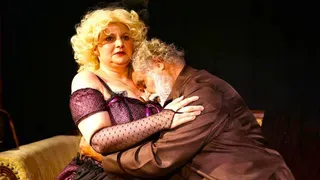May 20, 2010
The Girl Who Kicked The Hornet's Nest
Kay Bourne READ TIME: 3 MIN.
The bisexual, master computer hacker, warrior waif Lisbeth Salandar, both victim and avenger, and the gimlet eyed activist journalist Mikael Blomkvist return as a crime fighting duo in The Girl Who Kicked The Hornet's Nest, the disturbing third and final installment in Steig Larsson's Millennium Trilogy.
Larsson's trilogy clincher opens up the scope of the duo's adventures like an accordion at full breadth.
One warning to readers: while the warp of these books is intelligence, government spies and otherwise, including the superior mental calculations of Salander, the weft is violence.
The series began with a cold case study of a missing heiress that exposed a prominent Swedish family as corrupt, The Girl With The Dragon Tattoo. In the next adventure the series progressed to offer a broader palette of exposing the players behind Sweden's sex trafficking business, The Girl Who Played With Fire. The nail biting conclusion (in which some of the villainous characters continue to play the nefarious roles they had in the earlier books) reveals the crime scene as including evil at the heart of Sweden's government itself.
Along the way, Salandar develops a romantic attachment with Miriam Wu, for which she is dogged by the tabloids.
In real life, Larsson's journalism attacks on right-wing extremists and fascists in Sweden had resulted in such virulent threats from neo-Nazis he had gone into hiding (with his long time companion Eva Garbriellson). From these quarters he wrote the detective series. An appendix in The Girl Who Kicked The Hornet's Nest offers thumbnail sketches of the real life people who figure in the trilogy.
The book also has a preface which takes the form of an ode in prose to warrior women throughout the ages, those who do not respect gender distinctions. Stiegg writes, "and nowhere is that distinction more sharply drawn than in the question of armed combat," the foot soldiers.
The trilogy's squeeze play is meant to further disturb those racist and corrupt powerful figures in his homeland. Larsson, who termed himself among other things as a feminist, intended to write 10 novels in what he referred to as his Millennium series. He had completed nearly a half of a fourth novel when he died of an apparent coronary thrombosis at age 49, only months after he had delivered the initial three manuscripts to his publisher.
We can feel grateful, however, that we at least have the masterful trilogy which is capped by The Girl Who Kicked The Hornet's Nest, whose hair-raising outing advances Stiegg's aesthetic of exposure so memorably, and whose likely book sales success may encourage other detective novelists to do likewise.
Lisbeth Salander, shot in the head in the final pages of the previous novel and buried, is alive, though erroneously still the prime suspect for three murders in Stockholm. She is convalescing in a hospital ward under armed guard and but a few doors away from her estranged father, Alexander Zalachenko, a Soviet intelligence defector and long time secret asset to Sapo, Sweden's security police who have covered up his very existence.
He is also the person who shot Salander, and once he figures out she is so nearby, he plots to make good his earlier botched attempt. Nearly immobilized, she can hear him creeping up to her door in the middle of the night in what she surmises is a practice foray, but on the alert, she devises a defense. Then someone takes care of this problem for her. Lisbeth surmises, however, that the enemy of her enemy is not her friend at all, but her enemy as well. To her chagrin, she realizes if she is to survive and triumph, she needs to place her faith in journalist Mikael Blomkvist, whom she has barely tolerated throughout the second novel and with whom she communicates only through the computer.
Readers will feel both satisfied and melancholy when they turn the final page of The Girl Who Kicked The Hornet's Nest.






